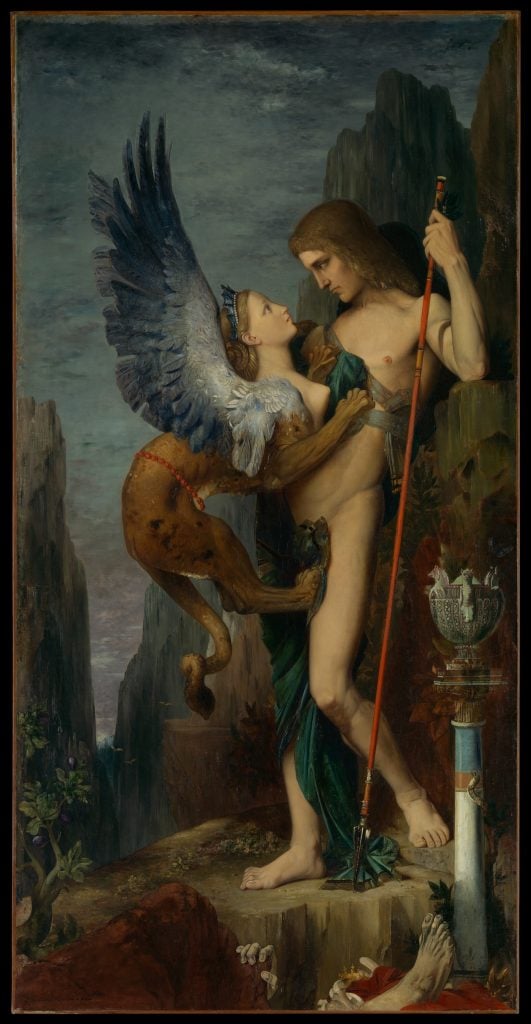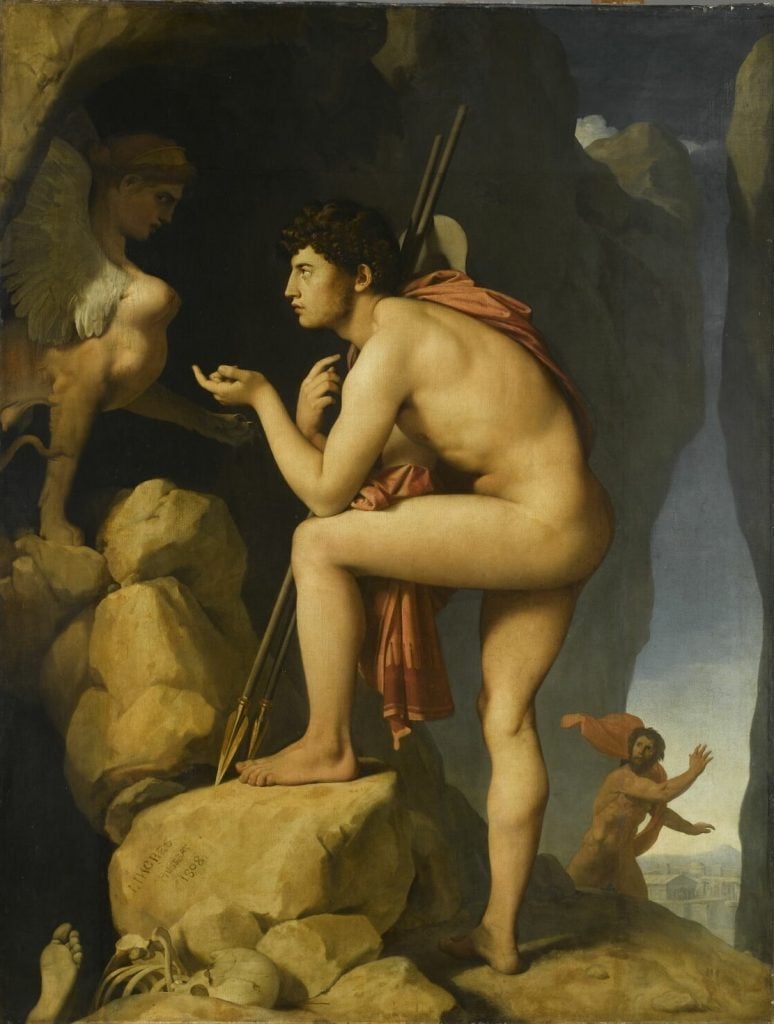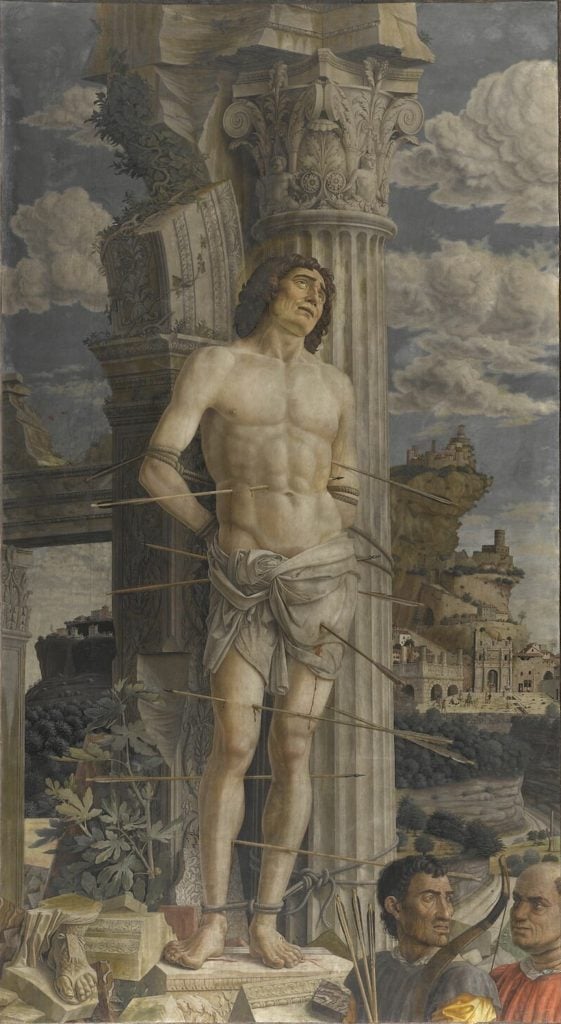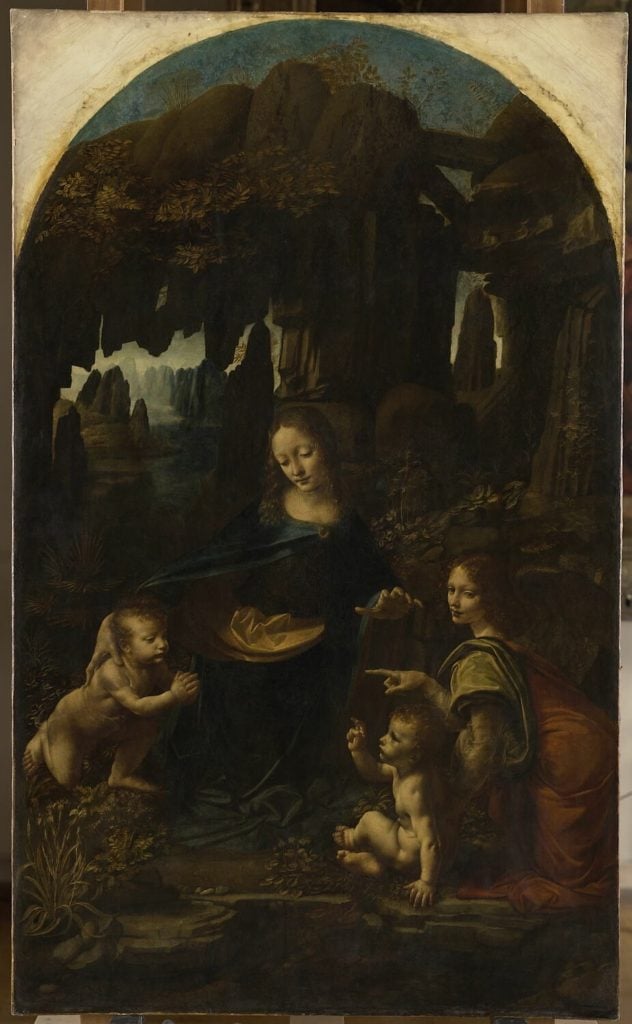Art History
‘Oedipus and the Sphinx’ Sensationalized Paris. Here Are 3 Things to Know About the Masterpiece
Gustave Moreau wanted to create a sensation, and he succeeded with this bold interpretation of a classical myth.

What becomes a legend most? After two years studying the Renaissance masters in Italy and five years back home in Paris, Gustave Moreau presented his answer with Oedipus and the Sphinx (1864). A work of moody, mysterious beauty, it sparked a sensation at the 1864 Salon, much to the artist’s relief.
Although Moreau had exhibited in the 1852 and 1853 Salons, as well as the 1855 Paris World’s Fair, it had been nearly a decade since he had shown a major painting. Moreau’s insecurity about his artistic training had prompted his time abroad, and now, nearing age 40, he felt the pressure to return to the Parisian art scene with a strong declaration of his mature style. “I must say that with such a work as this before me I am more inclined to diffidence than to anything like self-confidence,” he wrote to his friend, the painter and writer Eugène Fromentin in October 1862. “I scarcely dare to go ahead.”
Moreau spent considerable time working out the details of his composition, which presents a youthful Oedipus engaged in a standoff with the Sphinx, who asks all passersby a riddle they must answer on pain of death: “What goes on four feet in the morning, two feet in midday, and three feet in the evening?” His answer: “Man—who crawls on all fours as a baby, then walks on two feet as an adult, and then uses a walking stick in old age.”
The pair is confined to a shallow rocky outcropping before a receding gorge, and the foreground bears the discarded limbs and bones of the monster’s earlier victims—a warning of the mortal stakes at hand. Has Oedipus just correctly answered his opponent’s infamous riddle? Her paradoxical expression—shock, fear, or perhaps acceptance of her impending leap to the death—seems to indicate that the answer is yes.
As an artist, Moreau, too, might be seen as curiously sphinx-like. He doesn’t fully belong to either of the movements most commonly associated with him: Symbolism, which he is said to have influenced or anticipated, and Decadence, whose writers published embellished descriptions that clung about his work like an aura—in some cases, casting him as a bizarre artist-mystic. Instead, as Moreau scholars remind us, the artist considered himself above all things a history painter. This art, which he preferred to call “le grand art,” held the most esteemed position in the academic hierarchy of genres and placed him in a lineage with Jean-Auguste-Dominique Ingres, Jacques-Louis David, and Nicolas Poussin.
Still, Moreau’s style is rapturously idiosyncratic. Though he was academically trained as a child in the studio of François Èdouard Picot, a student of David, Moreau never rotely adhered to academic style. In the early 1850s, he announced to his father his ambition to “create an epic art that is not academic.” In this pursuit he sought a wide range of influences, including the Romantic works of Eugène Delacroix and friend Théodore Chassériau.
Moreau believed that art should excite the spirit, and he turned to imaginative fantasy, mythology, and poetry as models to express ideas and emotions. He also believed artists created through a divine, supernatural intuition, and in his artistic practice he strove for the elevated ideal against the growing materialism of mid-century France, exemplified by debates over the female nude and the advances of Realism. Moreau’s paintings feature an eclectic array of this “elevated” iconography: Salomes and their severed heads, nymphs, angels, gods like Apollo, and, in our case, a tragic hero.
The story of Oedipus, treated by classical writers like Sophocles and Ovid and famously taken up later by Freud, is here rendered with a slick, high degree of finish. It strikes a pleasing balance: the Sphinx’s strong body is set against Oedipus’s lithe frame, and her wings, in gauzy, lilac-tinged grays, echo his upturned arm, bent to clasp his crimson lance. Their dramatic appearance on this remote cliff edge is heightened by the ominousness of the desolate setting, with its mottled gray cloud cover, eerie light, and confined glimpse of the distance.
An erotic reading has often been applied to the work, owing to the protagonists’ closeness, the deliberately revealing placement of Oedipus’s flowing cloak, and the positioning of the Sphinx’s hind legs. This idea of a desirous and destructive Sphinx likewise reflects the fearful attitudes in mid-century France towards the menacing and predatory femme fatale, which emerged as the modern women sought new rights and status.
Other details may speak more directly to the spirit of the myth. Note the laurel leaves and the glint of a crown among the gruesome remains. These have been interpreted as the fall of both poet and prince, underscoring the reality that neither talent nor power has overcome the Sphinx’s wrath. The snake circling the column in the lower right has been associated with death, while the butterfly fluttering above the griffin urn is linked to the soul; together they allude to Oedipus’s triumph, a result also represented by the laurel leaves, a traditional symbol of victory.
Once owned by Prince Napoléon-Jérôme Bonaparte, Oedipus and the Sphinx has been in the collection of New York’s Metropolitan Museum of Art since 1921. It hangs in wonderful company, near Arnold Böcklin’s Island of the Dead (1880) in a gallery full of sculptures by Rodin (whose torqued, emotive bodies we might see as a poignant contrast to Oedipus’s seductive nonchalance). The painting’s beauty is undeniable, but its effect is palpable: this life-sized representation prompts us to look up, like the Sphinx, and join the charged duel of gazes, a siren song for would-be voyeurs. Here are some things you might not know about it.
The Towering Monsieur Ingres

Jean-Auguste-Dominique Ingres, Oedipus Explaining the Enigma of the Sphinx (1808). Courtesy Musée du Louvre.
With this painting, Moreau knew he was engaging directly with the work of Ingres. “Monsieur” Ingres, as he was by then called in a gesture of both respect and position, was for Moreau the most important artist from the previous generation of heroic French painters.
Ingres first developed his Oedipus Explaining the Enigma of the Sphinx in 1808, and, as was his practice, reworked and repeated the painting throughout his life. It presents a muscular Sphinx, her face concealed by shadow, guarding her lair and reigning above the remnants of her fallen victims. Oedipus is posed after a second-century CE Roman statue of Hermes Fastening His Sandal and, in the words of art historian and curator Robert Rosenblum, “calmly but firmly confronts the monster. His athletic body takes a position that suggests, in the tautened muscles of the legs, a virile strength and determination, and, at the same time, a noble ease that can even permit the right hand to free its protective grip upon the pair of javelins.”
Moreau not only knew Ingres’s work, he made four small drawings after it on the back of a book page. Both compositions share a grim, mountainous setting, are rendered in profile, depict a female Sphinx, and present common attributes: the javelin, cloak, strewn body parts, and hat (a petasus, barely visible in Moreau, where it hangs down his back). They also feature an idealized, coy Oedipus tranquil in the face of danger.
But Moreau’s composition also notably diverges from his predecessor’s. Most significantly, he eliminated the space between the dueling parties and attached the Sphinx to Oedipus’s chest and torso. Out of the shadows, the full power of her chimeric eagle-lion-human nature is on display. Moreau also reversed the hierarchy between the opponents, perhaps altering the power dynamic. Oedipus now peers down icily at a steeper angle, which causes the Sphinx to look up in a gesture more indicative of vulnerability. In both works the battle is played out through the gaze, but Moreau has eliminated Ingres’s gracefully rendered hands, the faint curl of Oedipus’s finger no longer drawing our attention.
As the Moreau scholar Peter Cooke and others have observed, there is a highly sculptural aspect to the enjoining of Moreau’s figures, like a classical marble, which serves to heighten both the immediate threat of physical danger and the charged, psychological tension. This formation into a unit likely comes from ancient Greek iconography present on gemstones and vase paintings, where, in one example, the Sphinx balances upon Oedipus’s lap. It may also speak to the period’s interest in myths and etymology. Though he published his paper in 1863, after Moreau had settled on this aspect of the composition, the linguist Michel Bréal argued that the word sphinx may have come from a Greek word that means to embrace, to clutch, or to cling to. Here she seems to hang miraculously from Oedipus, whose cloak protects his skin from her claws.
One final moment of clinging: a hand emerges from the pit of remains and grasps the rock edge. Is this the final rally of strength from the Sphinx’s most recent victim?
Saint Sebastian and Quattrocento Archaism

Andrea Mantegna, Saint Sebastian (1475/1500). Courtesy Musée du Louvre.
Oedipus and the Sphinx excited many, with one critic calling Moreau the savior of history painting. But it also drew criticism, and these complaints often spoke of the work’s archaism, its references to earlier Renaissance and classical models.
For his part, Moreau was highly intentional about his sojourn to Italy. “I know what is lacking in my studies and I shall not be able to work with serenity until I have filled these gaps in my artistic education,” he wrote to Fromentin in 1856. While abroad, he made hundreds of copies of Renaissance artworks by Il Sodoma, Raphael, Correggio, Luca Signorelli, Carpaccio and others, but his highest esteem was reserved for Michelangelo and Leonardo da Vinci. Emulation was an essential practice to classical training and history painting, and later in life, as a teacher in the École Nationale Supérieure des Beaux-Arts, Moreau would instill the same values in his students, urging them to learn by copying the Old Masters. “To be modern does not consist of searching for something outside of everything that has been done,” he explained. “It is on the contrary, a question of coordinating all that the preceding ages have brought us, to make visible how our century has accepted this heritage and how it makes use of it.”
Many commentators saw in the hard, linear style of Oedipus and the Sphinx the influence of Mantegna. “Not content with imitating the rigid drawing of the Mantuan painter, the artist has reproduced even the peculiar details of his style: the clenched fingers and toes, the fingernails and toenails outlined in black, the bizarre and symmetrical complications of the drapery,” wrote one critic. Although the Louvre wouldn’t acquire Mantegna’s Saint Sebastian (circa 1480) until 1910, it would have been known through reproductions. There is certainly resonance in the youthful, sculptural bodies and poses of the hero and saint, who occupy most of the compositions; the fig tree, too, often interpreted as a symbol of worldly sin, is present in each painting’s foreground.
But as Cooke has explained, no evidence reveals a preference for Mantegna over other Renaissance masters whose work he studied. Another likely influence is the frozen style of Carpaccio’s Saint George and the Dragon (circa 1504–1507), a fierce encounter with a rearing dragon (and a work Moreau had copied in its full-size while in Venice). It too displays the mangled remains of previous victims.
Somnambulism: Engulfed in a Dream

Leonardo da Vinci, The Virgin, the Christ Child, Saint John the Baptist and an Angel, also known as the Virgin of the Rocks (1483/1494). Courtesy Musée du Louvre.
Always engaging with the past, Moreau enjoyed borrowing something more mysterious from the Old Masters: the absorbed expressions and stable grace of their figures. This effect, which he praised as Michelangelo’s “ideal somnambulism,” conveys the sense of being engulfed in a dream. “One does not rest, one does not act, one does not walk, one does not meditate, one does not cry, one does not think in this manner on our planet, in our world,” Moreau wrote of Michelangelo’s figures.
Oedipus and the Sphinx was one of Moreau’s first works to display, as he would call it, “la belle inertie” (beautiful inertia), an aesthetic principle that would come to permeate most of his work. Indeed, much of the tension here comes from the incongruity between the protagonists’ transfixed expressions and the hostility we expect to see in such a momentous encounter. As Cooke has explained, “Although the figures contain a striking degree of material and psychological intensity, in its essence the drama of Oedipus and the Sphinx has been interiorised.”
Moreau praised the sense of mystery in painting, and deliberately cultivated it in his own work. He believed viewers should have a unique experience before a painting, and that the painter shouldn’t clearly prescribe meaning. In this he shared with Ingres what Cooke and art historian and women’s studies scholar Susan Siegfried have observed as a suspension of the moment of narrative action; this isn’t the dramatic crescendo of Rubens’s Raising of the Cross, but rather an ambiguous opening for the viewer to respond to Oedipus and his opponent with their own imagination.
Leonardo’s mysterious Saint John the Baptist (circa 1517–1520), which Moreau apparently displayed as a photograph in the vestibule of his house, would have been an inspiration, as would Da Vinci’s The Virgin of the Rocks (circa 1483–1494), with its entranced expressions and strange, melancholic landscape. Leonardo as an artist underwent a shift in mid-19th-century France, becoming more associated with the esoteric, mysterious, and sublime. Poet and dramatist Théophile Gautier described his Mona Lisa as a “Sphinx of beauty,” and, before Saint John the Baptist, novelist and poet Arsène Houssaye reported the feeling that “one is going to fall, where one falls, into the infinite abyss of dreams.”





